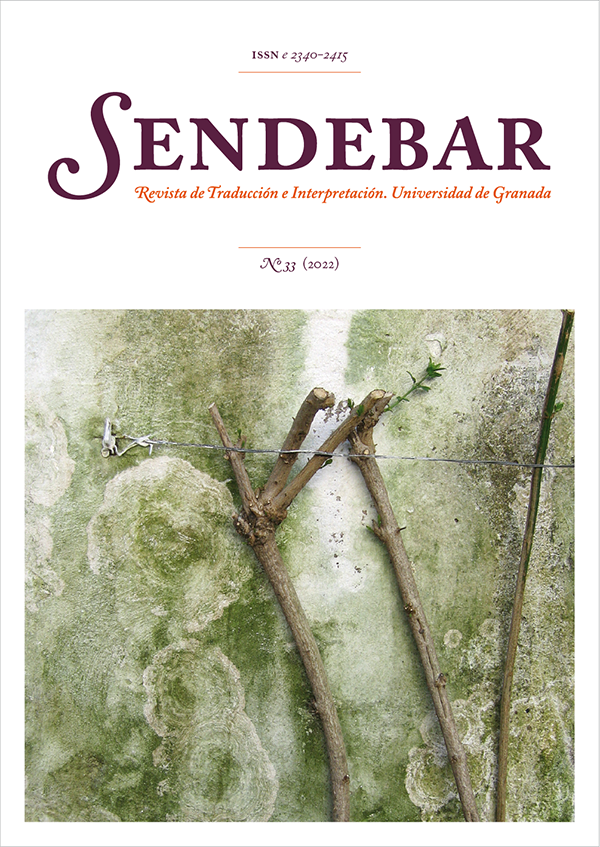Desafíos traductológicos en torno a la pluralidad en lengua china
DOI:
https://doi.org/10.30827/sendebar.v33.23653Palabras clave:
lingüística china, pluralidad, traducción chino-españolResumen
Las diferencias lingüísticas y culturales entre español y chino obligan a los traductores que trabajan con estas lenguas a hacer un esfuerzo significativo de comprensión y reescritura. La noción de pluralidad es un buen ejemplo de cómo estas diferencias lingüísticas producen interferencias en el proceso de traducción. Este trabajo se propone indagar cómo los traductores de chino a español han de enfrentarse a diferentes relaciones entre forma y significado en torno a la pluralidad, con implicaciones semánticas, pragmáticas y retóricas. A partir de un corpus de siete textos literarios traducidos, identificaremos y clasificaremos las principales fórmulas de expresión del número gramatical en chino. Nos detendremos en las decisiones de los traductores y en sus posibles repercusiones en la transmisión y comprensión de un texto determinado, para concluir que el morfema, unidad mínima significado, desafía desde lo más pequeño los paradigmas tradicionales de equivalencia en la traducción de chino a español.
Descargas
Citas
Acquaviva, P. (2008). Lexical Plurals. A Morphosemantic Approach. Oxford University Press.
Alarcos Llorach, E. (1999). Gramática de la lengua española. Espasa Calpe.
Bisang, W. (2013). Chinese from a typological perspective. 4th International Conference on Sinology, Taipei.
Chao, Y. R. (1969). Dimensions of fidelity in translation with special reference to Chinese. Harvard Journal of Asiatic Studies, 29, 109-130.
Chao, Y. R. (2011). A Grammar of Spoken Chinese. The Commercial Press.
Cheng, A. (2002). Historia del pensamiento chino. Edicions Bellaterra.
Comrie, B. (1989). Language Universals and Linguistic Typology: Syntax and Morphology. The University of Chicago Press.
Corbett, G. G. (2004). Number. Cambridge University Press.
Coseriu, E. (1967). Teoría del lenguaje y lingüística general: Vol. 2: Estudios y ensayos; 61 (2. ed.). Gredos.
Eco, U. (2008). Decir casi lo mismo: La traducción como experiencia. Lumen.
Fábregas, A. (2013). La morfología. El análisis de la palabra compleja. Síntesis.
Fraser, C. (2007). Language and ontology in early Chinese thought. Philosophy east & west, 57(4), 420-456. https://doi.org/10.1353/pew.2007.0045
Gao, X. (2003). En torno a la literatura. El Cobre.
García Yebra, V. (1984). Teoría y práctica de la traducción. Segunda edición revisada: Vol. I. Gredos.
García Yebra, V. (2006). Experiencias de un traductor. Gredos.
Gu, M. D. (2005). Chinese Theories of Reading and Writing. A Route to Hermeneutics and Open Poetics. State University of New York Press.
Hansen, C. (1983). Language and logic in ancient China. Univ. of Michigan Pr.
Iljic, R. (1994). Quantification in Mandarin Chinese: Two markers of plurality. Linguistics, 32, 91-116.
Iljic, R. (2001a). The Origin of the suffix -men 們 in Chinese. Bulletin of the School of Oriental and African Studies, 64(1), 74-97.
Iljic, R. (2001b). The Problem of the suffix -men in Chinese grammar. Journal of Chinese Linguistics, 29(1), 11-68.
Li, Y. A. (1999). Plurality in a classifier language. Journal of East Asian Linguistics, 8(1), 75-99.
Liu, J. J. Y. (1966). The art of Chinese poetry. University of Chicago Press.
Loar, J. K. (2011). Chinese Syntactic Grammar. Functional and Conceptual Principles (Vol. 9). Peter Lang.
Lü, S. (吕叔湘). (2002). Lu Shuxiang Quan Ji. Zhongguo Wenfa Yaolüe (吕叔湘全集,中国文法要略) [Compendio de gramática china]. Liaoning Jiaoyu Chubanshe.
Mou, B. (1999). The structure of the Chinese language and ontological insights: A collective-noun hypothesis. Philosophy East and West: A Quarterly of Comparative Philosophy, 49(1), 45-62.
Norman, J. (1988). Chinese. Cambridge University Press.
Packard, J. L. (2004). The Morphology of Chinese. A Linguistic and Cognitive Approach. Cambridge University Press.
Packard, J. L. (2016). Chinese Morphology (S. Chan, Ed.; pp. 215-226). Routledge.
Pegenaute, L. (2016). Aproximaciones teóricas contemporáneas a la traducción literaria. En I. Galanes Santos (Ed.), La traducción literaria. Nuevas investigaciones (pp. 5-29). Editorial Comares.
Ramírez Bellerín, L. (2004). Manual de traducción: Chino-castellano. Gedisa.
Rovira-Esteva, S. (2002). El paper dels mesuradors xinesos en la pragmática del text. [Tesis doctoral, Universidad Autònoma de Barcelona].
Rovira-Esteva, S.; Casas-Tost, H.; Tor-Carroggio, I.; Vargas-Urpí, M. 2019-2022. La literatura china traducida en España. Base de datos en acceso abierto. Disponible en: https://dtieao.uab.cat/txicc/lite.
Real Academia Española y Asociación de Academias de la Lengua Española. (2009). Nueva gramática de la lengua española. Espasa.
Sterk, D. (2018). The grammatical artistry of Chinese-English translation. En C. Shei & Z. Gao (Eds.), The Routledge Handbook of Chinese Translation. Routledge.
Sun, J., Meng, J., & Ni, H. (1988). Xi-Han Fanyi Jiaocheng (西汉翻译教程) [Manual de traducción español-chino]. Shanghai Wai Jiaoyu Chubanshe.
Tor-Carroggio, I., & Rovira-Esteva, S. (2021). Chinese literary translation in Spain up until 2020: A quantitative approach of the who, what, when and how. Skase: Journal of Translation and Interpretation, 14(1), 67-94.
Venuti, L. (1995). The translator’s invisibility: A history of translation. Routledge.
VV. AA. (2013). 2013 Zhongguo Dangdai Youxiu Zuopin Guoji Fanyi Dasai Tuijian Zuopin Ji (2013中国当代优秀作品国际翻译大赛推荐作品集) [Obras recomendadas del concurso internacional de traducción de obras destacadas contemporáneas de China 2013] (Renmin Wenxue Zazhishe).
VV. AA. (2015). Colección de Obras Ganadoras del I Concurso de Traducción Internacional de China. Ediciones en Lenguas Extranjeras.
Weinberger, E. (2016). Nineteen Ways of Looking at Wang Wei. New Directions Publishing.
Wenzel, C. H. (2013). Chinese Language, Chinese Mind? De Gruyter.
Xu, D. (2012). Plurality and Classifiers across Languages in China. De Gruyter.
Yip, P.-C., Rimmington, D., Fisac, T., & Roncero, L. (2015). Gramática de la lengua china. Cátedra.
Zhang, N. N. (2014). Expressing number productively in Chinese. Linguistics, 52(1), 1-34.
Zhang, N. N. (2015). The morphological expression of plurality and pluractionality in Mandarin. Lingua, 165, 1-27.
Zhang, K. (张珂). (2006). Lun Han-Xi Huyi Zhong de Dukeyi Yinsu (论汉西互译中的不可译因素) [Acerca de los elementos intraducibles en la traducción chino-español y español-chino]. Beijing Di Er Waiguoyu Xueyuan Xuebao, 134, 65-69.
Zhao, S. (赵士钰). (2001). Xin Bian Han-Xi Fanyi Jiaocheng (新编汉西翻译教程) [Nuevo curso de traducción del chino al español]. Waiyu Jiaoxue Yu Yanjiu Chubanshe.
Descargas
Publicado
Cómo citar
Número
Sección
Licencia
Terminos de Licencia Sendebar.

















